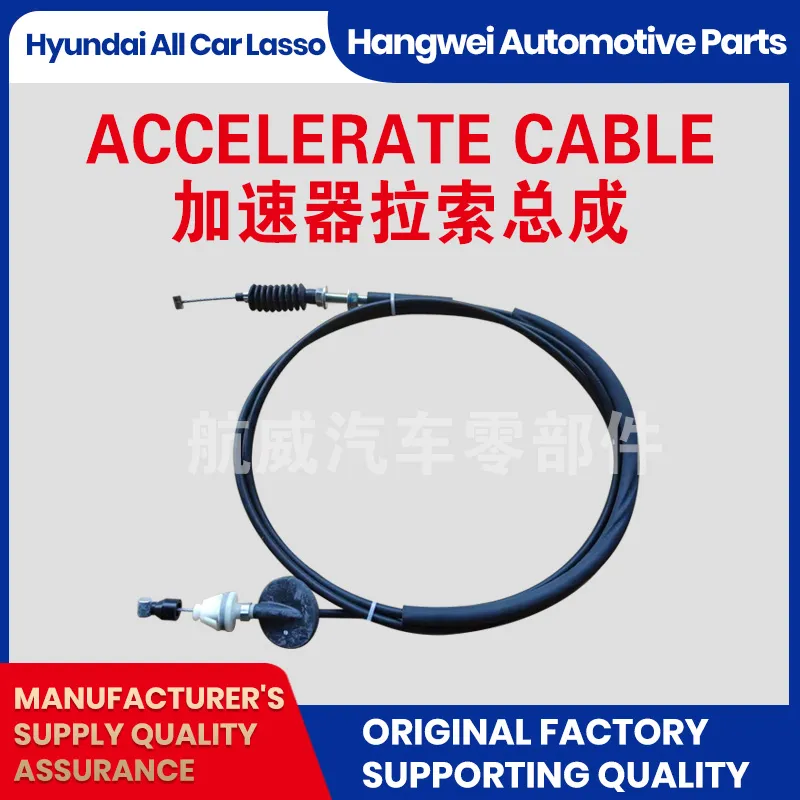Need a Throttle Cable with Smooth, Durable, Universal Fit?
Throttle control isn’t dead—why a modern throttle cable still matters
Drive-by-wire is everywhere, sure, but mechanical control cables keep winning in powersports, marine, generators, classic cars, and heavy equipment. The Accelerator Push-Pull Cable from Qinghe (Origin: Qinghe County Minjiang Street south, Wuzhishan Road east) is a good example: a compact assembly that reliably converts pedal motion into precise throttle actuation. To be honest, many customers say they prefer the tactile feel and field-serviceability—especially off-road where dust, water, and “why is there sand in everything?” is just Tuesday.
Industry trends at a glance
- Blended fleets: electronic throttle for passenger cars, mechanical cables for small engines, ATVs, UTVs, and retrofit projects.
- Durability-first specs: higher cycle-life, tighter bend radii, and lower friction liners (PTFE/HDPE) are becoming standard.
- Compliance-conscious sourcing: FMVSS 124 return-to-idle, corrosion tests (ASTM B117/ISO 9227), and IATF 16949 production control.
Typical applications
Passenger cars (legacy platforms), motorcycles, ATVs/UTVs, small trucks, forklifts, gensets, lawn equipment, marine throttle bodies, agricultural implements. In fact, a well-made throttle cable still shines where EMI immunity, simplicity, and easy field replacement matter more than software.
Product snapshot: Accelerator Push-Pull Cable
| Parameter | Typical spec (≈, real-world use may vary) |
|---|---|
| Inner wire | 7×7 stainless (AISI 304) or galvanized steel, pre-stretched |
| Liner / conduit | PTFE or HDPE low-friction liner, steel spiral armor, PVC/PE jacket |
| Stroke / travel | Up to 100 mm (custom), travel efficiency ≥ 92% |
| Min. bend radius | ≈ 100–150 mm depending on conduit type |
| Tensile load | Working 200–500 N; proof ≥ 1.5× working |
| Operating temp | -40°C to 120°C (liner-dependent) |
| Service life | ≥ 150,000–300,000 cycles at rated load, return-to-idle compliance |
| Corrosion | 96–240 h salt spray (ASTM B117/ISO 9227 options) |
| Certifications | ISO 9001; IATF 16949-capable production; FMVSS 124 design intent |

How it’s made (short version)
Materials are cut and pre-lubed; wire rope is pre-stretched, end fittings are swaged or die-cast zinc, conduit is spiral-wound and jacketed, then the assembly is crimped, proof-loaded, and 100% function-checked. Validation usually includes cycle fatigue at rated load, return-to-idle timing (important for any throttle cable), dimensional checks, and corrosion aging per ASTM/ISO protocols.
Vendor comparison (quick take)
| Vendor | Certs | Customization | MOQ | Lead time | Notes |
|---|---|---|---|---|---|
| HWEI (Qinghe) | ISO 9001, IATF 16949-capable | Ends, stroke, liners, jackets, brackets | Around 100–300 pcs | ≈ 3–5 weeks | Good value; automotive-focused |
| Generic A | ISO 9001 | Limited ends | 500+ pcs | 6–8 weeks | Lower cost, fewer options |
| Specialist B | ISO 9001, niche marine | High-mix, small batch | 50–100 pcs | 2–4 weeks | Premium pricing |
Customization tips
- Define load, stroke, and routing early; keep bend radius generous to protect the throttle cable liner.
- Specify return springs and idle timing per FMVSS 124 where applicable.
- Consider stainless hardware and PVC-free jackets for marine or salt-belt markets.
Mini case studies
ATV fleet retrofit: A rental operator swapped aging linkages for a PTFE-lined throttle cable. Complaints about sticky throttles dropped to near-zero, and maintenance intervals stretched from monthly to quarterly.
Generator OEM: After salt-spray failures, an ISO 9227 240 h spec with stainless barrels fixed seizure issues. Field returns fell by ~60% over two seasons, according to the client’s service team.
Testing and compliance
Look for documented cycle life (≥150k cycles), salt spray (96–240 h), proof-load testing, and return-to-idle performance within regulatory limits. Certifications like ISO 9001 and IATF 16949 signal process control; FMVSS 124 is the safety anchor for accelerator systems in the U.S.
References
-
Clutch Line: Braided, Leak-Proof, OEM-Grade PerformanceNewsNov.10,2025
-
Throttle Cable: Durable, Smooth Control & Universal FitNewsNov.10,2025
-
Throttle Cable: Durable, Smooth, Universal Fit, Easy InstallNewsNov.10,2025
-
Clutch Line: Durable, Leak-Proof, OEM-Grade PerformanceNewsNov.10,2025
-
Hand Brake Cable | Custom, Universal & Trailer SolutionsNewsNov.10,2025
-
Clutch Line: High-Pressure, OEM-Fit, Corrosion-ResistantNewsNov.03,2025
